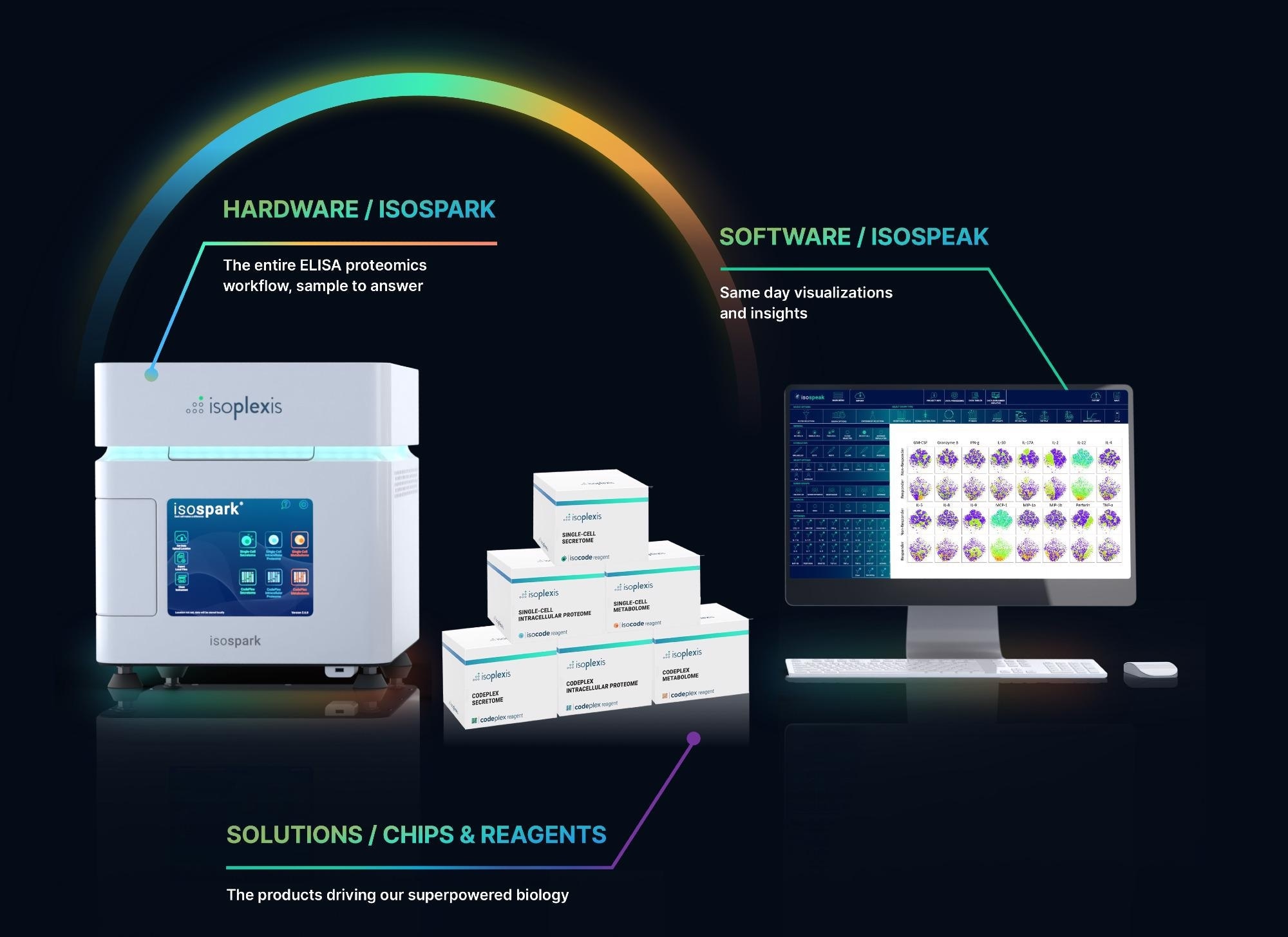Can you introduce yourself and tell our readers about your role at IsoPlexis?
My name is Steve Kosteski, and I am the Vice President of Global BioPharm, here at IsoPlexis. I joined the company back in 2018 when we started trading our products commercially. The company was founded in 2013, behaving more like collaborative biotech for a number of years, having spun out from Caltech and Yale.
I was one of the first commercial employees here at the organization. Back then, I feel like we were about 35 people. We have certainly seen a lot of growth since then and employ over 400 people today. I have seen quite a few things along the way regarding the technology we develop. We started the physical delivery of IsoLight systems at the end of 2018, and today we have over 210 IsoLight and IsoSpark instruments placed worldwide.
It is a very exciting time for me at the moment, in terms of my ability to communicate the company’s value proposition and educate our customers in regards to what we do here with single-cell proteomics, and also to take on a substantial role with key accounts. I work with some of the top 20 BioPharms in the world, where we have instrumentation in place or offer them services, we work to collaborate with them on new technologies and applications.
My role is to make sure those customers are happy, supported, and educated on our technology. We work more collaboratively and a strategically with them, we don’t want to have just a vendor/purchaser type of relationship
IsoPlexis is a single-cell proteomics company. Please, can you tell us more about some of your specific missions and goals?
Our main value proposition is revealing unique immune biomarkers in small subsets of cells. We call it the ‘democratization’ of the correlative single-cell functional information. There are many ways to get proteomics information, but what we see is often that information is not actually functional. We work with customers in Cell Therapy, Autoimmune, Infectious Disease, and Cancer Biology, offering each the ability to understand their products and their patients better.
We are trying to evangelize and introduce people to the technology because we see significant value in fully understanding those processes, whether it be in discovery, preclinical, or phase one or phase two clinical trials.
The availability of this new ‘data layer’ gives users functional information about immune biology mechanisms and this information has been shown to be clinically correlative. This is important because previously, people would obtain proteomic information but found that it did not correlate well with the patient response. One of our strengths at IsoPlexis is that a significant number of our data sets - over a hundred publications’ worth - is actually showing this clinical correlation to our single-cell functional phenotype.

Image Credit: IsoPlexis
You have said that superhuman cell biology is changing the course of advanced medicine and complex diseases. Why is this the case, and what role does IsoPlexis play in the broader human health space?
I can answer this question with two examples. For instance, we have customers who are working in the COVID-19 space. We are all wearing masks and trying to stay healthy, but some people have contracted the disease and are in the ICU.
We have seen customers remove PBMCs from those patients and identify specific cells – monocytes, for instance – showing high inflammatory cytokine secretion levels. Being able to capture this information from the live single cells is vital because it shows us the biological driver information of the current disease state.
The monocytes in those diseased patients are considered superhuman cells because they’re super active, but they are active in a bad way, secreting lots of proteins and causing inflammation in those patients. You could call them supervillain cells. Understanding the mechanism of that disease means being able to identify immune biomarkers we could potentially target to make the patients feel better.
On the other side of the coin is developments in immunotherapies, for instance, cell therapy companies designing new CAR-T products which are genetically engineered to attack, for example, cancer tumors. Those are also superhuman cells. You could call them superhero cells. They are designed to be more potent and targeted than the traditional T-cell, and characterizing these cell products helps us identify the better product for treating the patient.
The characterization of those cells is what we uniquely do here at IsoPlexis. We can identify these small subsets of highly functional cells that orchestrate a response. These polyfunctional cells secrete multiple cytokines and if we can identify these mechanisms of both response and therapy, we can design better therapies and monitor what happens in the patient downstream. That is why we call them superhuman cells because the cells involved in the orchestration of these responses are working harder than other cells to either help or harm the patient.
Despite advances in the field of single-cell proteomics in recent years, there are still some challenges concerning the complexity of data and difficulties in the identification of proteins. How do your products at IsoPlexis help to overcome some of these challenges?
Historically, proteomics was done with mass spectrometry. This approach provides lots of data but traditionally involves sending that data off to a bioinformatics team for weeks or months before you get the data back, and you can’t make decisions about the next step in the process because you are a hostage to the data.
Flow cytometry looks mostly at protein surface markers, so you know what the cell phenotype is, but you don’t know what that cell is functionally doing for instance, in the tumor microenvironment.
Bulk cytokine data allows you to capture proteins from a matrix-like serum or plasma, but you can’t track those proteins back to the cells who secreted them, that’s why single-cell functional proteomic data is so important
Single-cell work, outside of flow cytometry, was mostly transcriptomics and gene expression. It also provided tremendous amounts of informative data, but again, you would have to run the assay then send this off to the bioinformatics team. Months would go by, but you still could not act or perform the following up experiment. Even with all that, RNA is not the endpoint protein.
One of the goals here at IsoPlexis is that, even though we provide a tremendous amount of data, we can provide actionable information within a few minutes after the system has finished running. This lets people make decisions about the assay they ran today, designing what they are going to run tomorrow without being held hostage to the data. It is about moving projects forward much more quickly with data to support decision-making.
A lot of those legacy technologies are extremely difficult to use. We have aimed to create these small benchtop instruments with simple touch screens on the front that are otherwise entirely automated. This has removed the need to hire experts to set up and operate these instruments. I think one of the greatest things about our technology is accessing the data quickly. We don’t want customers to have to wait for results; we want them to make decisions quickly and take action.
7.Take a Look Inside the IsoLight
Take a virtual in-lab demonstration of IsoPlexis' products by clicking here!
You offer a wide range of services and products, including your IsoSpeak software, single-cell proteomics protein solutions, and your IsoLight system. Can you tell us more about your services and the advantages of having a company that can provide a wide range of proteomics services in one place?
As mentioned, we are working to democratize proteomics data, and that means we want to provide access to data in all shapes and forms. Here at IsoPlexis, we try to make sure that the data is available irrespective of the customer’s setup. Many of our customers buy instrumentation, have the IsoSpeak software, and can run the samples themselves, but this is not always the case. Sometimes a startup does not have a lab facility, for example.
In these circumstances, we have a group of certified services providers that I manage here at IsoPlexis. Customers can send their samples to those certified services providers to access the data regardless of their circumstances. Where organizations want to work with us directly, for instance, as part of phase one or phase two clinical trials, we offer the ability to have them send the samples to us, and we will run the samples for them and provide them with the data.
The other thing we are trying to do here at IsoPlexis is create instrumentation’ hubs.’ Each of our instruments offers multiple functionalities and can run different applications. Currently, the systems can run low volume highly multiplex automated ELISA, single-cell secretome, and single-cell signaling assays. This increases the value of that system and allows labs to justify the purchase to their management.
As we progress, we continue to develop new applications to offer on the same instrumentation, meaning customers do not have to buy a second or third different device to do something new. The goal is to add redundancy and make the same product usable for many different applications.
A prime example is our new Duomic technology that you can read about on our website. We combine proteomics with transcriptomics for the same single cell. It’s a very exciting future application.
The IsoSpark and the IsoLight are excellent examples of this principle. For example, the IsoSpark is an imager, ELISA processor, and cellular incubator, all in one. It has a footprint of only 18” by 18” while offering automation and the ability to access this data in a very simplistic fashion. Overall, we have tried to streamline the process and reduce the cost.
You also conduct several webinars on your platform, covering the various research areas your technology can be used in, including immunotherapy and oncology. Why are these webinars so important to IsoPlexis, and what can people expect if they sign up for one?
We are an organization that is growing. That means that educating our customers on the power of our technology is important for us, which is a significant driver in our webinar series. We communicate with the customers, speak to them about their projects and educate them on how our technology can help them access this new valuable biology.
Having key thought leaders sharing how the technology has been used to enhance their research or patients’ lives is also very important. This approach gives customers the ability to see real-life use case examples of how others use the technology and where it might fit within their research roadmap.
One of our mantras here at IsoPlexis is ‘follow the data,’ so we tend to talk less about our instrumentation and offerings. Instead, we talk about what tremendous importance the data offers the researcher or clinician, present this to our research collaborators and customers, and discuss the instruments as a tool. We do not spend a lot of time talking about the instruments because the instruments are intuitive, automated, and designed to produce invaluable data. The uniquely correlative data is the important part.

Image Credit: Alpha Tauri 3D Graphics/Shutterstock.com
What do you believe the future of medicine for complex diseases looks like? Are you hopeful that we will continue to develop innovative technologies and see more medicines being developed for these diseases?
The future looks bright. Less than ten years ago, some of the most impactful current therapies did not exist and were believed to be impossible to create. Immunotherapies were a foreign concept a decade ago, and now there are many global companies that we work with whose fundamental mandate is to develop these cellular or antibody-based immunotherapies.
The point is we do not know what we do not know, so the goal is to try to provide as much impactful information as possible to help researchers develop new approaches for treating complex diseases.
Where can readers find more information?
Check out IsoPlexis here: https://isoplexis.com/
About Steve Kosteski
Steve Kosteski joined IsoPlexis in 2018 and is currently the Vice President-Global BioPharm. Steve has over 30 years of life science experience starting his career in life science laboratory research.

Steve then moved to the commercial side of the life science industry working in applications, sales and commercial management.
About IsoPlexis

IsoPlexis is dedicated to accelerating the fight against cancer and a range of our toughest diseases by producing the world’s most precise, award-winning detection systems. By revealing unique immune biomarkers in small subsets of cells, we are advancing immunotherapies and targeted therapies to a more highly precise & personalized stage.